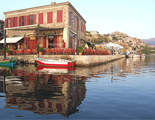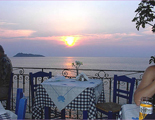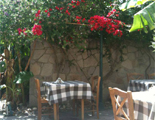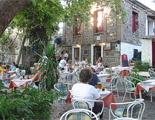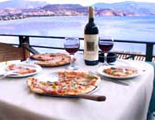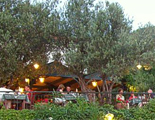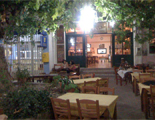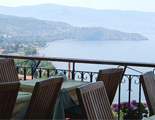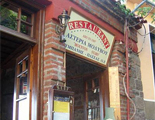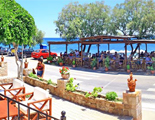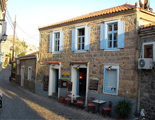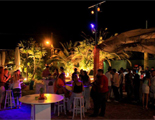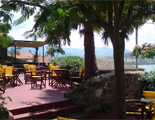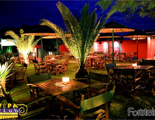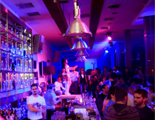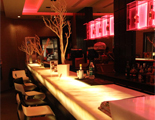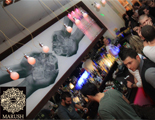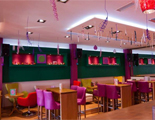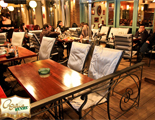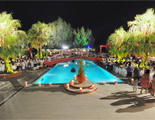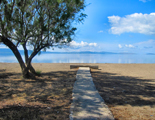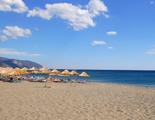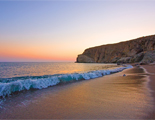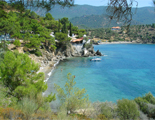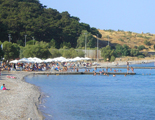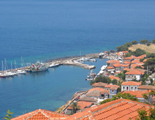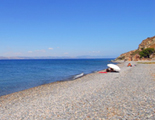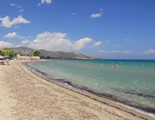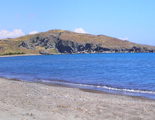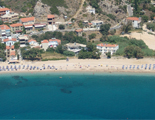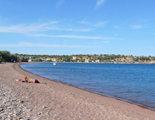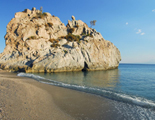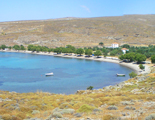 Lesvos Travel Guide
Lesvos Travel Guide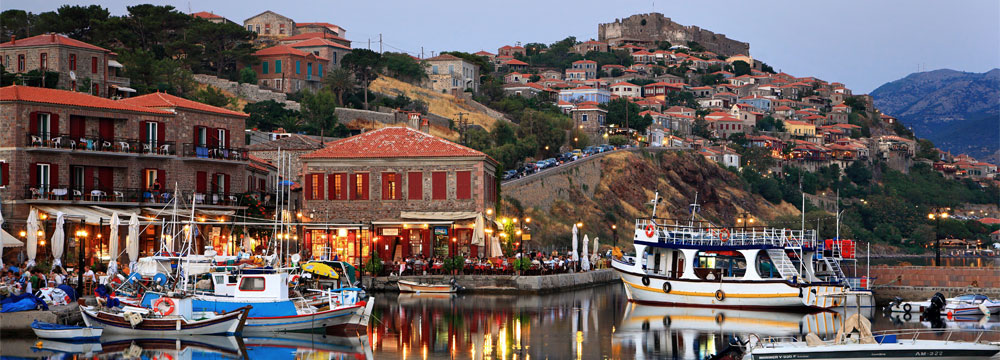
The Island of Lesvos was named after the son of Lapithos (and grandson of Aeolus), called Lesvos, who visited the island from Thessaly after having an oracle and, thus, married the daughter of the island’s king Makareas, Mithymna. Some suggest that Makareas was the son of Helios.
Lesvos has proved to have been inhabited in the prehistoric years, and more specifically in the Neolithic Era. Several Neolithic settlements have been discovered in different places in Lesvos. The first inhabitants of the island were the Pelasgians. Next to arrive were the Achaeans and the Aeolians who arrived during the second half of the 2nd Millennium B.C. The prehistoric culture was extremely developed and findings include tools, castles, artistic objects, cobblestones, millstones, blades and vessels.
The Ancient and Classical Times constituted a period of glory for Lesvos, which was famous for its naval power and already exported wine in the 7th century B.C.. No wonder that many artists and philosophers lived in Lesvos during the 7th century B.C. The Lesviots controlled many cities in the coasts of Asia while there were six important ancient cities on the actual island. Lesvos went from oligarchy to tyranny, until democracy was established after 650 B.C. thanks to the ancient politician Pittakos, who was considered one of the Seven Wise Men in Ancient Greece. In the 6thcentury, the island was conquered by the Persians.
Lesvos participated in the Peloponnesian War, initially as an ally of Athens, but eventually became an ally of Sparta. Many cities in Lesvos were destroyed during the war and, finally, the island was dominated by the Spartans from 405 to 394 B.C. In 334 B.C., the island became part of the Macedonian Empire and, after the death of Alexander the Great, it was conquered by the Ptolemies of Egypt.
In 231 B.C. an earthquake destroyed part of the island (Pyrra). During this century, the island lost its glory.
In 88 B.C. the Romans conquered Lesvos. During the Roman period, Lesvos was prosperous and many important projects were completed: the Theatre, the Aqueduct of Moria, the mosaic floors of the villas in Top Scala and the Temple of Thermia Artemis.
The Christians arrived in Lesvos in 52 A.C. during the early and mid-Byzantine period (325-1071 B.C.), and, during the first centuries of the Christian Era, Lesvos was a commercial centre characterized by prosperity and glory. However, it was attacked and despoiled several times by the Scythians, the Vandals, the Saracens, the Catalans and the Russians.
In 1204, Lesvos was conquered by the Crusaders and it came under the domination of Baldwin, the emperor of Istanbul. In 1336, the island became again part of the Byzantine Empire. During the Byzantine Period, many monasteries were built on the island, which by then belonged to the “Province of Islands”.
From 1355 to 1462 Lesvos belonged to the Genoan family “Gatelouzo”. This was a very peaceful period and the island was quite powerful.
The Ottomans tried to occupy the Island in 1455 but did not succeed. They came back seven years later and eventually succeeded destroying most of the island killing the majority of the inhabitants. The few Christians that survived had to leave their homes and move towards the centre of the island. The situation worsened due to attacks by the French, the Venetians, the Knights of Rhodes and the Saracens. In the 1770s, the Psarians attacked Lesvos twice and destroyed two cities (Plomari and Plagia). In 1817 and 1822, the Lesviots unsuccessfully tried to revolt against the Turks.
Beginning in 1839, the island started to improve its position by shifting its economy from agriculture towards industrialization. The island’s population increased during the second half of the 19th century from about 10,000 to about 130,000. Christians were in charge of the industrialization process because the Ottomans remained loyal to the traditions of their religion. This is why the Turks on the island became less and less powerful.
Lesvos was liberated from the Turks in 1912 and was integrated into Greece in 1914. After the disaster of Asia Minor, many Greek inhabitants of the area refuged to Lesvos and the remaining Turks left the island. The economy of the island was hurt due to the interruption of commerce with the Minor Asia coasts.
Lesvos was occupied by the Germans from 1941 to 1944. Earlier, many inhabitants died during World War I and later during the Civil War (1940-1949).
After 1960, the island’s economy improved significantly and, especially, in the 1980s due to tourism. Today, Lesvos is a very prosperous island with over 100,000 inhabitants. It is an organized island, which hosts a university, banks, enterprises, and many public services.
According to the Greek Mythology, after a fight between Zeus and Hera, Hephaestus was thrown by Zeus on Limnos because he took Hera’s side. Ever since, Hephaestus lived on the island and taught Sindies, the first Limnos’ inhabitants, the art of working with iron. It is also said that Sindies welcomed and helped Hephaestus and this is why he decided to teach them how to create various iron objects.
According to the myth, the poet and prophet Orpheus was divided in pieces by Maenads in the mountains of Pieria. Then, his head ended up in Andissa and his lyre in Mytilene. This is how he continued to sing and vaticinate in Lesvos.
According to the Greek mythology, the majority of the places, villages and settlements on the island were named after the daughters and sons of king Makareas. Mytilene was one of his daughters, whose name was given to the island’s capital.
Aphrodite, in order to thank him, gave him an alabaster with myrrh. When he smeared his body with the myrrh, he became a very young and very handsome man that every woman desired. Eventually Sappho also fell in love with him but the other men on the island were furiously jealous and finally killed him. So Sappho was very sad and killed herself falling from cape “Lefkatas” on the island of Lefkada in the Ionian Sea.
Lesvos attracts a plethora of Christians annually, mainly due to the Monastery of Saint Raphael with its unique history (the Saint repeatedly appeared in the dreams of an Orthodox Christian, guiding him to find his Orthodox Image) and contemporary miracles, and the also miraculous Virgin Mary of Agiasos with the embossed image of Virgin Mary created by Saint Luke with mastic and oil.
Moreover, the Monastery of Taxiarchis in Mandamados is a very important monastery with an interesting story of a unique monk who was the only to survive from the Turks thanks to a miracle of Taxiarchis.
Although every area of the island hosts an important church, visitors should also seek picturesque chapels and churches in villages across Lesvos. The following churches and monasteries are not to be missed: The Monastery of Leimonas with its rich book collection, and the Monasteries of Panagia Myrsiniotissa, Perivoli, Damandri and Saint Ioannis Theologos, as well as the Churches of Saint Therapontas (the largest on the island), Panagia Glykofilousa in Petra built in a high rock 40 m. high in the 18th century, Saint Athanasios and the Metropolitan Church of Mytilene.
The following museums are situated in Lesvos and they are certainly worth a visit:
The Archaeological Museum of Lesvos is hosted in two buildings: the exhibits of the old building include figurines, pottery and jewellery from the Prehistoric to the Roman Era, plus Aeolian columns from the ancient temple of Clopedi, coins, tombstones and statues in the yard. In the new building visitors may admire the exhibition “Lesvos from the Hellenistic to the Roman Era”, which also includes mosaics and frescos from luxury Roman houses. The two buildings are situated in Mytilene within walking distance and the ticket costs from2 to 3 Euros.
In Lesvos, there are two folklore museums; the Folklore Museum of Mytilene and the Folklore Museum of Plomari. Both attempt to present to visitors the way of life on the island. Exhibits include traditional clothes, house objects, tools, coins, historic documents, ceramic pots, etc.
The Varvagianni Ouzo Museum in Plomari is a unique museum, where visitors can see how ouzo is created. Tel.: +30 22520 32741, +30 22520 32231.
The Soap Museum, again in Plomari, reveals to visitors the process of soap production. This is ideal for children and teenagers. Tel.: +30 22520 32600.
The Museum of Industrial Oil Production is located in Agia Paraskevi and offers to visitors a detailed exploration of all oil production stages. Tel.: +30 22530 32300.
The Theofilos Museum is situated in Voreia, about 4 km. from Mytilene, and was created by the renowned art critic Stratis Eleftheriadis-Teriade as a tribute to Theofilos. In the museum, there are 86 paintings all created in the last 6 years before Theofilos’ death. The ticket costs from 1 to 2 Euros. Tel.: +30 22510-41644.
The Teriade Contemporary Art Museum is situated again in Voreia, and hosts paintings of great Greek painters like Theofilos, Tsarouchis, Kanellis and Rorris. Visitors may explore the museum rare collection of books that include images of the works of the most important artists (e.g. Picaso, Matisse, Leger, etc.). The ticket costs 2 Euros. Tel.: +30 2251023372.
The Museum of Natural History/Petrified Forest in Sigri was established in 1994 and it is a UNESCO Natural Monument. Visitors can take a journey in time, exploring the events that took place in the Mediterranean Sea during the past 20 million years! Apart from the museum, the Museum Geopark with rare plant fossils and volcanic rocks, is certainly worth a visit, whereas the Petrified Forest itself is not to be missed! The ticket costs from 2 to 10 Euros. Tel.: +30 2251047033, 2253054434.
The Museum of Paleontology and Geology-Vrisa Collection of Natural History in Polichnitos is the ideal museum for kids! Who could imagine that during a vacation, there would be the possibility to see fossils of vertebrate and invertebrate? Or touch a gigantic turtle shell of 2.5 meters long? The collection also hosts mineral specimens, rocks and ores of Lesvos, a Zoology Department and a Botany Department. Tel.: +30 2252061890.
The Georgios Iacovides Digital Museum is an innovative museum located in Hithira, which is the birthplace of the painter G Iacovides. The museum uses the most contemporary digital technologies in order to present the painter’s work and life. The building that hosts the museum is a beautiful token of neoclassic architecture in the Aegean Islands. Tel.: +30 2251051128.
The Byzantine Ecclesiastic Museum of Lesvos is situated in Mytilene and hosts religious objects, embroidered vestments, Orthodox Images and historic books. Tel.: +30 2251028916.
Lesvos is a beautiful big island with many towns and villages. This is why visitors should devote more than a week in order to discover it!
Mytilene is the island’s capital and its main port. It is built on seven hills, has an imposing castle and about 25,000 of citizens. Mytilene offers several accommodation choices, as well as interesting cultural events, a wide variety of taverns and restaurants, and of course a vibrant nightlife.
Agiasos is a picturesque little town (with 3,000 citizens) on the slopes of mount Olympus. The village is dotted with neoclassic houses of traditional island architecture and narrow streets. Visitors should not neglect to buy ceramic pottery and carved wood!
Approximately to the west of Mytilene, there is Polichnitos a small village with stone houses and red roofs. Apart from its thermal springs, Polichnitos also attracts visitors due to the ruins of a castle and the gorgeous beach of Skala.
The second largest town of Lesvos is situated in the southern end of the island and is called Plomari. The ouzo of Plomari is the most famous ouzo in Greece, thus exported. The town is gorgeous, built right by the sea, with charming narrow streets, beautiful churches and lovely cafeterias.
At about 40 km. to the northwest of Mytilene, the Kalloni area awaits visitors in order to reveal the beauties of its seven main villages (Argiana, Parakoila, Skala Kallonis, Papiana, Kerami, Dafia and Arisvi) and its four complementary villages (Agra, Anemotia, Skalochori, Filia) (mountainous in their majority). The area has a unique splendour, since it is built around the homonym gorgeous bay and features historic monuments, amazing monasteries and ruins of ancient temples.
Eresos is situated in southwestern Lesvos and has about 1600 citizens. This is where the renowned ancient Greek female poet, Sappho, was born. The city attracts many tourists thanks to the amazing sandy beach of Skala Eresou, at a distance of about 4 km, which hosts traditional coffee shops, lively beach bars and picturesque shops.
Molyvos or Mythimna has to be the most romantic place of Lesvos. With narrow cobbled streets, traditional stone houses and a magnificent castle, Molyvos has a unique atmosphere of old time charm. Cameras are definitely indispensable here!
Lesvos has three wonderful castles: The Mytilene Castle, the Mythimna Castle and the Sigri Castle.
The Castle of Mytilene stands out on top of the hill close to the Mytilene port. This is one of the largest castles in the Mediterranean Sea whose construction was initiated in the Byzantine Era and was completed during the Gattelusi domination. A large earthquake in 1384 destroyed a large part of the castle and it was afterwards rebuilt. This castle is divided in three parts with the middle part including a jail complex, a seminary and an underground water tank. Visitors may also admire the Gattelusi Palace, the blazons of Gattelusi and Paleologi, and the castle’s amazing walls!
The Mythimna or Molyvos Castle is one of the very well maintained castles in the eastern part of the Mediterranean Sea. The castle was built in the Byzantine years and some additions were made by the Ottomans. Its grandiose is amazing and it is even more impressive when it is nicely lit up at night.
The Sigri Castle was built during the Ottoman Era in the 18th century. It is not a very big castle, but it has an interesting perfect square shape, four towers on the corners and beautiful arches.
Apart from its three castles, Lesvos hosts many other archaeological sites:
The Ancient Theater of Mytilene is located in the area of Agia Paraskevi. This was a very spacious theatre that could host 15,000 people! Its exceptional acoustics were renowned in the Ancient Times and many compare it to the legendary Epidaurus Theatre in terms of acoustics.
The Ancient Temple in the area of Clopedi in Central Lesvos, which was devoted to Apollo, is saved till today in a quite good condition. Visitors may see the Aeolian pillars and sculptures of the Classical Greek period (4th century B.C.)
The Roman Aqueduct of Moria is an amazing oeuvre of the 3rd century A.C. that used to connect Agiasos with Mytilene. It was made of the characteristic grey marble of Lesvos and its amazing architecture, with arches and boulders, made it look like an imposing temple. The Aqueduct is situated close to the village Lambou Myloi.
In the area of Apothika, Agra and Makara, there are significant archaeological findings known as Ancient Makara. In Apothika, there was an impressive 6 meters high wall that is now only up to 3 meters, and was built according to the island’ traditional structure.
At about 15km. from Mytileme there is the prehistoric settlement of Thermi built in the 3rd millennium B.C. There are ruins of houses and walls, and the first prehistoric neighbourhood organized in blocks.
The Ancient Andissa was one of the two most powerful cities in western Lesvos in Ancient Time. Today, there are only some ruins of its walls because the city was attacked and destroyed by the Romans in 167 B.C.
The Acropolis of Eressos is today called “Vigla”. On the ancient ruins of the acropolis, the Byzantines built a castle, part of which is still visible today. There is also a water tank built either in the Roman or Byzantine Era.
Although the research for the discovery and analysis of the findings of the Ancient Port of Pyrra has not yet been concluded, researchers believe that in this position was a lively port and a dockyard. It is widely believed that the city of Pyrra was destroyed due to an earthquake in 231 B.C., but the area was reconstructed and inhabited in the Byzantine Era. Findings also include women’s clothing and Byzantine coins.
Last but not least, the Ancient Temple of Messa in Kalloni is one of the most important archaeological monuments on the island. That was the worship centre of the Aeolians. Part of the temple foundations and some columns have survived and have been placed in their right positions in order for visitors to be able to visualize the ancient temple.
CLIMATE
The climate in Lesvos is the typical Mediterranean climate with mild winters and warm -but not too hot- summers full of sunshine. The months with the highest quantity of rain are December, January, February and November. However, there is plenty of sunshine even during winter.
During summer, minimum temperatures range from 19 to 22 °C, whereas maximum temperatures range from 28 to 31 °C, on average. This is due to the summer breeze and strong northern winds of the Aegean Sea, which keep the temperature at a significantly lower level than that of the mainland. Lesvos has about 2868 hours of sunshine per year, with the months May to August having at least 300 hours per month. Snow in Lesvos is extremely rare. In general, the weather on the island is pleasant and mild all year long.
TELEPHONE
The national prefix for Greece is +30 if you are calling from abroad. All numbers in the capital Athens start with the prefix 210 and are followed by 8 digits (e.g. 210-3227400).
The Area Code for Lesvos is: +30 22510, but in Plomari the code is 22520, and in Kalloni it is 22530. If you wish to call abroad, you have to start by dialling the other country’s national prefix (i.e. 0049 for Germany, 0044 for England etc.) and continue with the area code and the number where you wish to call.
CURRENCY
Euro €
Euro Coins: 1 and 2 euro coins (gold and silver colour), 10, 20 and 50 cents (gold colour) 1, 2 and 5 cents (copper colour)
1 euro = 100 cents.
Euro Bank Notes: Are available in 5, 10, 20, 50, 100, 200 and 500. It is not always easy to receive change for 200 and 500 Euro Notes.
BY AIR
Lesvos features an airport, which is connected with the Athens International Airport but also with airports in other cities and islands in Greece (Thessaloniki, Crete, islands of the Aegean Sea). In addition, the Lesvos’ airport is connected with several airports around the world (with charter flights during summer). The flight duration from Athens is about 35 minutes.
For more information, accurate timetables and tickets costs please visit: Athens International Airport: www.aia.gr
Lesvos Airport “Odyseas Elytis”, Tel.: +30 22510 61490
Thessaloniki Airport “Macedonia”, Tel.: +30 2310 368311
Olympic Air
www.olympicair.com
Tel: 801 801 0101 (land line) / +30 210 3550500
Aegean Airlines
www.aegeanair.com
Tel: 801 11 20000 / +30 210 6261911 (domestic calls)
Tel: +30 210 6261000 (mobiles or calls from abroad)
BY BOAT
Lesvos is connected by boat with the port of Piraeus and the trip duration ranges from 8.5 to 12 hours (the boat usually stops at Chios before arriving to Lesvos). Moreover, the island is connected by boat with Thessaloniki and Kavala on the mainland of Northern Greece and with many Aegean islands: Chios, Ikaria, Kalymnos, Kos, Limnos, Mykonos, Rhodes, Samos, and Syros.
It is also connected on a daily basis via ferry boat with Aivali in Turkey.
For more information, accurate timetables and tickets costs please visit: Nel Lines: www.nel.gr
Aegean Speed Lines: www.bluestarferries.com
LOCAL BUSES
Lesvos is the third biggest island in Greece and local transportation is well organized. There are buses that connect: Mytilene with Agiasos, Argenos, Gera, Eressos, Sigri, Kalloni, Mesotopos, Napi, Petra, Molyvos, Plomari, Polichnitos, Vrysa, taxiarchis and Mandamados, passing by many picturesque villages and beautiful beaches on the island. There are also monthly bus cards available with 25% of discount.
KTEL (long distance buses) of Lesvos: +30 22510 28873, www.ktel-lesvou.gr
TAXI SERVICE
Taxis are available at multiple spots on the island, and taxis offer high quality services and diversification:
Throughout Lesvos:
a) Lesvos Taxi Services: ideal for Dutch, German, English and of course Greek speakers
www.lesvostaxiservice.webs.com
Tel.: +30 6972203663, +30 6934895338
b) Taxi-Lesvos: Taxis with adjustable seats for disabled people and children
www.taxi-lesvos.gr
Tel.: +30 6945957948
In Mytilene:
Tel.: 2251022919, 2251023500, 2251025900, 2251022064
In Plomari
Plomari Taxi Service ( ): ability to make online reservations.
www.taxi-plomari.gr
Tel.: +30 22520 33559, +30 6932485431
In Petra:
Tel.: +30 22530 42022
In Mithymna:
Tel.: +30 22530 71480
In Papadou-Geras:
Tel.: +30 2251082020
WATER TAXI
There are no water taxis at Lesvos.
BOAT
Lesvos has some amazing isolated beaches and visitors may choose among many alternatives when considering a boat trip. There are sailing trips, boat trips around the island, boat trips to islands nearby or Turkey, etc. Information is available in local travel agencies.
BANKS & ATMS
There are several bank branches in Lesvos (also hosting ATMs), situated in Mytilene, Kalloni, Papados, Plomari and Polichnitos.
MONEY EXCHANGE
Money can be exchanged in the bank branches listed above.
POST OFFICE
The Greek post office is called ELTA and you can find the main post offices of the island in Hora where there is also a branch of the Hellenic Post Bank. Post Boxes in Greece are YELLOW for normal post, usually with 2 slots for INTERNAL POST (meaning inside Greece) and post for ABROAD. RED Post Boxes are rarer and they are used for URGENT mail. You shouldn’t expect to find such boxes in the island. REGISTERED mail is always handled and given a receipt for at the POST OFFICE.
The Post Office in Lesvos is very well organized and has branches in several places such as Agia Paraskevi , Agiasos , Antissa , Eressos, Kalloni, Mantamadou, Mythimna, Mytilene, Pappados, Petra Post, Plomari, Polichnitos, , Pythagorio.
POLICE STATION
There are police stations in the following locations on the island:
Mytilene: Tel.: +30 22510 58800, e-mail: [email protected]
Andissa: Tel.: +30 2253056222
Agiasos: Tel.: +30 2252022777
Kalloni: Tel.: +30 2253022100
Plomari: Tel.: +30 2252032222
MUNICIPALITY OF LESVOS
The Municipality of Lesvos has a functional website in terms of information provided: http://www.mytilene.gr.
Tel.: +30 2251027777, e-mail: [email protected]
Radio Taxi: 2251023500, 2251025900, 2251022064
Municipal Police: 2251043338
Tourist Police: 2251022776
Lesvos Port Authority: 108, 2251040827, 2251024115
Hellenic National Meteorological service: +30 2109699101-3
Elpa (Car breakdown tourist information service): 174
EMERGENCY NUMBERS
Police: 100
Fire Department: 199
Ambulance: 166
HEALTH
Andissa Health Centre: Tel.: +30 22530 56440
Kalloni Health Centre: Tel.: +30 22530 22222
Plomari Health Centre: Tel.: +30 22520 32151
Pollichnitos Health Centre: Tel.: +30 22520 41111
PHARMACY
There are about 90 pharmacies in Samos, situated in Mytilene, Kalloni, Agiasos, Polichnitos, Andissa, Mythimna, Taxiarxhes, Papados, Palaiokipos, Petra, Mantamados, Mistegna, Eressos, Agia Paraskevi and in other villages.
Interesting information is available on the website of the Lesvos Pharmaceutical Association: www.fsl.gr
Skala Kallonis is a gorgeous large sandy beach, ideally situated in the Kalloni Bay. Here the waters are crystal clear, shallow and usually calm. In addition, there are many, very friendly pelicans around the beach. Several water sports are available on Skala Kallonis and for those who want to eat or have a refreshing drink, there are cafeterias, taverns and restaurants. What more could anyone ask for, especially during a family vacation?
Parakoila is a small, tranquil beach in the Kalloni Bay with dark grey sand and shallow calm waters. Very close to the beach there is also a wetland that hosts many birds species. Moreover, the homonymous village, which is only a few minutes away, has unsurpassable natural beauty and amazing waterfalls. Parakoila is ideal for an all-day excursion that begins with a swim in the serene beach and a unique experience in the natural treasures nearby.
Mikri and Megali Tsichranda are two beaches in the wider Kalloni area in the northern part of the island. They are beautiful rocky beaches, with dark grey sand. Their morphology was created due to a volcano explosion and their amazing landscape is ideal for relaxation. For those wishing to swim alone, there is a great chance to do that in Mikri Tsichranda.
Petra could be described as the summer dream for foreigners. It is a 3 km long sandy beach, which hosts umbrellas and sunbeds and offers water sports services, while there are several taverns, cafeterias, restaurants and touristic shops along the coast. A diving centre awaits divers to explore the gorgeous sea bottom. In the sea right in front of Petra there are 4 little islands, Ai-Giorgis, Mikro Nisi, Glaronisi and Myrmigi, offering to swimmers a picturesque view!
Vatera is the longest beach in Mytilene and one of the longest of the Aegean Sea. In its more than 8 km. long coast visitors may find sand and a few pebbles, sunbeds and umbrellas, swings, taverns and cafeterias, and even accommodation. Moreover, those who seek water sports will be more than satisfied in Vatera, since the beach offers many water sports facilities. Plus, the area is ideal for fishing and snorkelling.
In the western part of Lesvos lies one of the most beautiful beaches of the island, with golden sand and crystal clear waters: Skala Eressos is the meeting point for wind surfers and water skiers. This is a lively beach that hosts sunbeds and umbrellas and is surrounded by bars, taverns, restaurants and cafeterias. Right next to the beach, there is a small lake with many turtles.
Agios Ermogenis is a picturesque small beach named after the homonymous chapel that lies right above it. Saint (Agios in Greek) Ermogenis is the patron Saint of the athletes. The beach has beautiful green waters that owe their amazing colour to the pine trees hanging above the sea water. The beach is not organized, but there are showers and a tavern. The idyllic scenery of this beach usually attracts youngsters and couples.
Tsamakia is an organized sandy beach in the town of Mytilene. It is the most easily accessible beach for those that have chosen to stay in the island’s capital. The beach offers many amenities, including umbrellas, sunbeds, showers, beach volley and beach soccer courts, but visitors have to pay an entrance fee to the beach. Tsamakia lies underneath the homonymous grove and the beach itself is surrounded by quite a few trees.
Haramida is a surprisingly beautiful beach surrounded by pine trees and nested in a gorgeous inlet that could easily be the island’s card postal. There are a few picturesque taverns around the beach, which is usually crowded in August and during the weekends. It is not by chance that a diving centre is situated here since the bottom of the sea has an interesting morphology and hosts stunning fish and underwater flora. Haramida truly is a paradise on earth!
Molyvos is a very popular beach in Northern Lesvos, not only because it offers many amenities (showers, locker rooms, sunbeds, umbrellas, beach bars, taverns, cafeterias), but also because while swimming, one has a breathtaking view of the Molyvos Castle that dominates the hill above the beach. Around the beach there are hotels and apartments, while a visit in the Molyvos village is absolutely mandatory!
The thermal springs of Eftalou are famous for their healing properties, ideal for rheumatisms, gynaecological diseases and arthritis. Doctors and holistic therapists suggest that results are even better if after the thermal spa, patients take a swim at the sea. The beautiful pebbled beach of Eftalou is extremely tranquil (thus attracting nudists) and has transparent waters. The rock at the edge of the beach perfectly completes the extraordinary scenery adding a sense of infiniteness helping visitors clear their minds from worries, relieving stress.
Kanoni is a small pebbled beach close to the town of Mytilene, in the area of Thermi. The beach is organized and offers many amenities, whereas the beach bars around it serve refreshing cocktails and tasteful snacks. Here, the music plays loud and visitors dance and have fun all day long. Last but not least, water sports are also available in this lively beach.
Chrousos is an isolated beach of amazing beauty in the western part of Lesvos. The beach is covered with thick brown sand and the waters are transparent and cold, because the river Lagadas flows into the sea at the one edge of the beach. Although Chrousos is far from being organized there is a canteen that serves snacks and refreshments, and sometimes fresh fish.
Agios Isidoros is also called “the beach of Plomari”, as it is only 2 km away from Lesvos’ second town in terms of population. The beach is organized and offers many amenities, but what strikes the visitor is the diversity of its colourful pebbles. Agios Isidoros has been increasingly attracting tourists and the area around it today hosts many hotels and studios, taverns, and cafeterias. Last but not least, the beach has been voted as the 7th cleanest beach in Greece.
Gavathas is a spacious sandy beach in Northern Lesvos which offers beautiful views towards a little rocky island called “the Gavathas’ Island” right opposite the beach. Quite often, the sea currents bring algae to Gavathas and this area is ideal for fishing. The swimmers here, apart from enjoying a tranquil swim, also have the opportunity to watch the “silver seagulls” that live on the Gavathas’ Island. The whole experience is unique and truly relaxing.
For the majority of visitors Tsonia is an unknown destination; a secret paradise of the island's residents. This spacious gorgeous beach has red sand and crystal clear waters. Quite often, swimmers have the unique opportunity to see dolphins which are very impressive as they swim and jump in and out of the water playing one with another or with the waves. Since the beach is not organized but very clam and secluded visitors are advised to bring supplies with them. Finally, this beach is accessible by boat from the Sea Horse Hotel in Molyvos.
Melinda is a stunning sandy beach where a huge rock dominates the landscape. The waters here are transparent and, thus, ideal for fishing. Bold and fit swimmers should try to dive from the top of the rock! Visitors are also advised to bring sports shoes, as on the west side of the beach there is a gorgeous path of about 2.5 km that leads to “Panagia Kryfti” (a cave devoted to Virgin Mary) and to a basin with thermal waters.
Sigri is a sandy beach that is not organized, but hosts taverns and cafeterias, allowing visitors not to carry many things with them apart from their hats and towels. The waters here are shallow and transparent which makes Sigri ideal for families. The beach has a splendid view to the Sigri Castle when facing the land, and an amazing view to the island of Nissiopi when facing the sea, offering a unique 360 panorama to swimmers!
Tarti is a golden sand beach which offers many amenities to visitors, including sunbeds and umbrellas, hotels, studios and apartments, as well as taverns and restaurants. The latter are to a large extent responsible for Tarti’s popularity, since some of the best traditional seafood dishes are served right on this beach’s taverns and restaurants. What more can one desire after a refreshing swim?
The Lesvos gastronomy is unique and it is highly connected with Ouzo consumption.
Shrimps or Mussels “saganaki”
Shrimps or mussels are fried in olive oil with tomato juice, feta and spices. A gastronomic treasure!
Fried zucchini
Zucchini are fried in olive oil and filled with cheese, eggs, onions and spices. Their sweet and salty taste is amazing!
Anchovies with salt, oil and vinegar
A very salty strong taste, ideal for accompanying Ouzo. In the global cuisines, this specialty is used to spice up many recipes.
Stuffed vine leaves or “Ntolmadakia”
Made of vine leaves that are stuffed with rice, onions and pumpkins, this traditional Greek dish is full of the aroma of Lesvos.
Lakerda Fish
This dish is made of bonito fillets that bloat three days with sea salt. Again, an amazing “ouzomezes”!
Kalloni Sardines
This unique product is converted into a tasteful dish, consumed the exact same day it is prepared (after being sank in salt for several hours).
Salted mackerel
Locally fished mackerel is introduced in salt for 2-3 days and then served with onions, oregano and vinegar. A great “mezes” for ouzo!
Liver with oregano
Liver is served in a different way in Lesvos, with oregano and olive oil having an particularly strong taste!
Lesvos actually is a blessed Aegean Island; its land is very fertile and its products are renowned globally. The most remarkable Lesvos’ products are the following:
Ouzo
Ouzo is a drink that is part of the island’s tradition, since its residents have always connected ouzo with social life. Drinking ouzo is always accompanied by eating certain light dishes, called ‘ouzomezedes”. More info on the worldwide famous ouzo of Lesvos is available at www.ouzoland.gr.
Oil
No other Aegean Island presents both the quality and quantity of olive oil Lesvos does. Lesvos’ oil has a unique taste and texture and a very high nutritional value due to the elevated unsaturation of fatty acids!
Wine
The wine of Lesvos is called “Methymnaion” and it is exclusively produced in the area of the Petrified Forest at Sigri. In the ancient years the wine of Lesvos was the most expensive one in Greece! Today the red and white wines produced on the island still preserve their unique taste and aroma.
Cheeses
The most famous cheese of Lesvos are gruyere and ladotyri. Lesvos’ gruyere is a hard cheese with a mild sweet taste, whereas ladotyri is totally one-of-a-kind, consisting in a hard cheese with a pretty spicy flavour. Both are not only to be tasted on the island, but also to be brought home!
Olives
There are three different kinds of olives in Lesvos: ksydates, ksyralates and tsakistes. All three kinds have more than 25% oil content and they are really tasty and nutritious!
Morsels (Salted seafood)
Morsels (salted seafood) are very often consumed with ouzo, so this probably explains why they are so popular on the island. Lesvos is globally renowned for the kalloni sardins and for its anchovies.
Bakery products
Visitors will find here amazing bakery products that are produced by the women association according to completely traditional procedures. Even pasta is locally produced this way!
Almond macaroons
The Lesvos’ almond macaroons are called “gemata” or “prospesmata”. They have a great aroma and a light taste.
Many events are organized in Lesvos every year, specifically during summer.
The Carnival Celebrations in Mandamados take place on Shrove Monday (usually in February or March, depending on the date of Orthodox Easter). There is a carnival parade, a feast, singing and dancing and the revival of traditional fishing.
The Bull Feast is held in Agia Paraskevi on the Friday after Easter. It is a popular local event that lasts 3 days, is devoted to Saint Haralambos and includes dancing, eating and horseback riding.
Expo Aegean is an exhibition of local products hosted in the Mytilene marina. It is usually organized in mid-June and apart from an exhibition of local products, the event is accompanied by many cultural events that involve music and dancing.
The Lesviot Summer is a series of events taking place from July 1st to August 31; there are concerts of many different kinds of music, theatre plays for adults and children, speeches, religious feasts, storytelling, painting exhibitions, fairs, and dance shows. The majority of these events are organized in the Castles of Mytilene and Molyvos. For more information: www.lesvoscalendar.gr (the website is in Greek only)
The 1st Ouzo Festival is organized in July 2013 and specifically, 6-7th July at the Plomari marina, 13-14th July at the Mytilene marina and 10th July at the Museum of Natural History in Sigri. Events would include slide shows, tasting ouzo and local products, concerts and workshops.
The 2nd Greek-Turkish Commercial and Cultural Festival is held in Mytilene on June 22-25 2013. It includes exhibitions of Greek and Turkish products, music and traditional dances from both countries and several celebrations in the context of the cooperation of the two populations.
The Beach Street Festival is organized in Vatera on July 25-28 2013 and is an innovative gathering of graffiti artists from all over the world, accompanied by rock music concerts. The graffiti artists will paint an abandoned hotel in Vatera and will create the most multinational graffiti project ever!
The International Eresos Women Festival is the largest globally festival for homosexual women. 2013 is its 13th year of operation and it includes folk music, dancing, photography, excursions and tours, parties, workshops and seminars. It will take place in September. More information: www.womensfestival.eu
Among the religious feasts, the most important are the feast for the Assumption of Virgin Mary on August 15th in Agiasos, which includes celebrations with free wine and food, live music and dancing, and the feast of Saint Theodoros, which is held on the first Saturday of
It is obvious that Lesvos visitors will certainly not be bored while on the island. More information on specific events is available via the municipality of Lesvos.
Lesvos is a very large island with many things to see and do. It has diversified landscapes and a strong gastronomic culture, not to mention its amazing beaches! Visitors should not miss the opportunity of discovering these beauties and make sure they have water, sport shoes and hats/sun blocks with them during their exploration.
Moreover, since Lesvos is affected by the strong northern winds of the Aegean Sea (“meltemia”), usually the real feel of the temperature is lower than 30 degrees Celsius. Therefore, light jackets are required in the evenings.
In addition, the bottom of the sea in many areas in Lesvos is covered with rocks and there are also dazzling rocky beaches. So, it would be wise for visitors to have sea shoes.
Finally, Lesvos is connected by boat with many other Aegean Islands (Chios, Limnos, Ikaria, Fournoi, and islands of the Dodecanese) and with Turkey. Combining a vacation on Lesvos with a short visit to some of these destinations is certainly a good idea!
Anyone looking for a holiday in nature or a little adventure will most definitely be satisfied in Lesvos. There are several trekking paths, with trekking tours including the mountains Olympos and Lepetimnos, as well as participation in the production of olive oil! Details and trips’ plans are available in local travel agencies.
Lesvos is a beautiful island with many different areas, interesting plants, traditional agricultural villages and breathtaking beaches. So, an organized jeep trip certainly sounds like a good idea!
More information in local travel Agencies
Scuba diving is very organized in Lesvos, both for experienced divers and for beginners. Diving centres are located in Petra and Haramida. Diving routes include several reefs and wrecks, but, either way, the sea bottom is fantastic in this part of the Aegean Sea: divers will see colourful sponges, beautiful nudibranchs (sea slugs), labyrinths and underwater corridors!
Lesvos is among the most famous bird watching locations in Europe. There are several different species of birds that live on the island and many more that stop by Lesvos on their migration trip or that migrate here for a few months. More information is available at:www.lesvosbirding.com
Lesvos is situated in the Northeastern Aegean Sea, which is famous for its crystal waters and wide variety of landscapes. Lesvos’ visitors may take a boat tour of the island, visit islands nearby or take a daily trip to Turkey (so, do not forget to bring your passport with you)!
The Petrified Forest in Sigri is one of the two of its kind globally (the other is situated in Arizona, USA). This unique forest was created about 15-20 million years ago after a volcano explosion. Visitors may admire petrified trees spread across 150 square kilometres!
The majority of shops are located in Mytilene and Plomari, but there are also many shops in all touristic areas of the Island.
Art objects/Galleries
Myth Art Gallery by Theofilos Mantzoros
Located in Mythimna, this gallery houses artistic objects and jewellery for men, women and children.
Tel.: +30 22530 71711
Pesmazoglou Antiques
Situated in Mytilene, this unique gallery hosts paintings, furniture, decorative objects, porcelain and even carpets.
Tel.: +30 2251022575

 Print this page
Print this page
